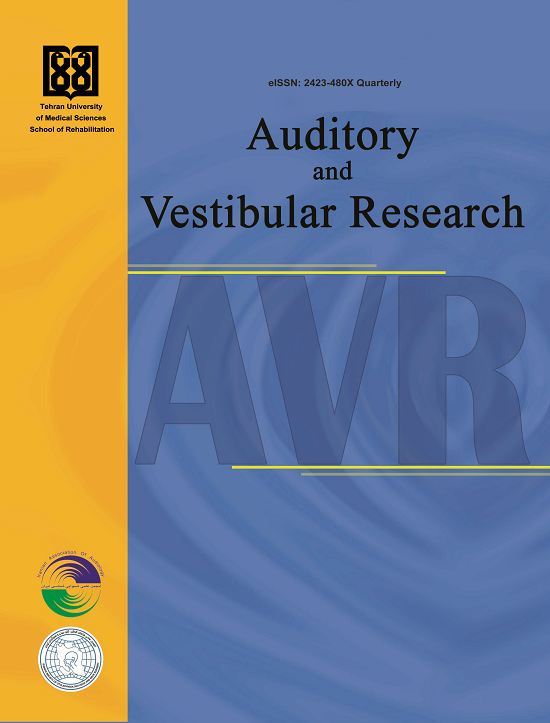Auditory Processing Rehabilitation Follow-up through Speech-evoked Auditory Brainstem Response in Contralateral Noise; A Case Report
Abstract
Background: Auditory training (AT) is an effective intervention for auditory processing disorder (APD), and its outcomes are usually assessed through behavioral and electrophysiological tests. Among objective tools, speech-evoked auditory brainstem response (s-ABR) has been used to evaluate AT effects, and it has shown promise, but s-ABR recorded in contralateral noise—a method activating both afferent and efferent auditory pathways—has not been applied to monitor rehabilitation progress in APD.
The Case: Here we compare pre- and post-intervention different tests' results of a 7-year-old boy with APD (with documented deficits in dichotic processing and speech-in-noise perception) to investigate which is the most appropriate tool for assessing rehabilitation efficacy. The case underwent behavioral and electrophysiological evaluations, including s-ABR with and without contralateral noise, before and after 15 sessions of targeted AT tailored to the child’s specific processing weaknesses. Post-training results revealed significant improvement in behavioral tests and questionnaire scores. S-ABR assessments also demonstrated improvements, including increased V/A slope as well as improvements in wave latencies and amplitudes, with more pronounced changes observed in recordings with contralateral noise.
Conclusion: This case highlights the novel use of s-ABR in contralateral noise as a promising objective tool for monitoring auditory rehabilitation in APD. While behavioral assessments remain the gold standard, this electrophysiological test may provide valuable complementary information, particularly for patients with limited behavioral test cooperation or when behavioral results are unreliable. As this case report involves a single child with APD, further studies are needed to validate these findings in broader APD populations.
2. Weihing J, Chermak GD, Musiek FE. Auditory Training for Central Auditory Processing Disorder. Semin Hear. 2015; 36(4):199-215. [DOI:10.1055/s-0035-1564458]
3. Musiek F, Baran J, Bellis T, Chermak G, Hall J, Keith R, et al. Guidelines for the diagnosis, treatment and management of children and adults with central auditory processing disorder. Virginia: American Academy of Audiology; 2010. [Link]
4. Wilson WJ, Arnott W, Henning C. A systematic review of electrophysiological outcomes following auditory training in school-age children with auditory processing deficits. Int J Audiol. 2013; 52(11):721-30. [DOI:10.3109/14992027.2013.809484]
5. Yencer KA. The effects of auditory integration training for children with central auditory processing disorders. Am J Audiol. 1998; 7(2):32-44. [DOI:10.1044/1059-0889(1998/018)]
6. Krishnamurti S, Forrester J, Rutledge C, Holmes GW. A case study of the changes in the speech-evoked auditory brainstem response associated with auditory training in children with auditory processing disorders. Int J Pediatr Otorhinolaryngol. 2013; 77(4):594-604. [DOI:10.1016/j.ijporl.2012.12.032]
7. Filippini R, Befi-Lopes DM, Schochat E. Efficacy of auditory training using the auditory brainstem response to complex sounds: Auditory processing disorder and specific language impairment. Folia Phoniatr Logop. 2012; 64(5):217-26. [DOI:10.1159/000342139]
8. Schochat E, Musiek FE, Alonso R, Ogata J. Effect of auditory training on the middle latency response in children with (central) auditory processing disorder. Braz J Med Biol Res. 2010 ;43(8):777-85. [DOI: 10.1590/s0100-879x2010007500069]
9. McArthur GM, Atkinson CM, Ellis D. Can training normalize atypical passive auditory ERPs in children with SRD or SLI? Developmental Neuropsychology. 2010;35(6):656-78.
[DOI: 10.1080/87565641.2010.508548]
10. Lotfi Y, Moossavi A, Javanbakht M, Faghih Zadeh S. Speech-ABR in contralateral noise: A potential tool to evaluate rostral part of the auditory efferent system. Med Hypotheses. 2019;1 32:109355. [DOI: 10.1016/j.mehy.2019.109355]
11. Schochat E, Matas CG, Samelli AG, Mamede Carvallo RM. From otoacoustic emission to late auditory potentials P300: the inhibitory effect. Acta Neurobiol Exp (Wars). 2012; 72(3):296-308. [DOI:10.55782/ane-2012-1902]
12. Pickles J. The Centrifugal Pathways. In: Pickles J. An introduction to the physiology of hearing. 3thed. Bingley, UK: Emerald; 2008.p.240-258
13. Musiek FE. Frequency (pitch) and duration pattern tests. J Am Acad Audiol. 1994 Jul;5(4):265-8. [PMID: 7949300]
14. Fathollahzadeh F, Jalilvand Karimi L, Akbarzadeh Baghban A. [Development and Assessment of Dichotic Digit Test in Persian Speaking Children]. Medicine Rehabilitation of Journal Scientific. 2017;6(3):125-34. Persian. [DOI:10.22037/JRM.2017.1100473]
15. Moossavi A, Mehrkian S, Karami F, Biglarian A, Mahmoodi Bakhtiari B. Developing of Persian version of the BKB sentences and content validity assessment. Aud Vestib Res. 2017;26(1):27-33.
16. Mehboodi R, Javanbakht M, Ramezani M, Ebrahimi AA, Bakhshi E. Normalization and Validation of the Persian Version of the Scale of Auditory Behaviors. Arch Rehabil. 2025; 26(1):134-49. [DOI: 10.32598/RJ.26.1.3923.1]
| Files | ||
| Issue | Articles in Press | |
| Section | Case Report(s) | |
| Keywords | ||
| auditory processing disorder auditory training speech-evoked auditory brainstem response | ||
| Rights and permissions | |

|
This work is licensed under a Creative Commons Attribution-NonCommercial 4.0 International License. |






